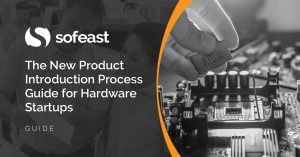 In post number 6 we continue to focus on new product development. This sub-step, phase 5.1, is dedicated to products that contain electronics. (Don’t forget that you can see the whole series on developing a new product here).
In post number 6 we continue to focus on new product development. This sub-step, phase 5.1, is dedicated to products that contain electronics. (Don’t forget that you can see the whole series on developing a new product here).

If your product requires a printed circuit board (PCB), this falls under the ‘hardware design’ element of this phase. We will not go into too much detail of how to design a PCB, but will however go over the basic steps behind best practices (Source: National Instruments tutorial 6894).
Step 1 of the PCB design starts with the understanding of what it is required to do and then goes onto researching each of the individual physical components (such as resistors, capacitors, transistors, diodes, ICs and other components). Part research and selection requires trial and error and a structured methodology to understand how each component works within the overall design of the PCB.
Step 2 is all about generating a schematic of the PCB design, also known as capture. The schematic capture uses a CAD design interface specifically for PCBs which have all the required product symbols of the circuit components. The schematic is a design representation in the form of symbols connected together by lines which is known as a net, an example of a schematic diagram is shown below:
Step 2 also includes simulation. Once the schematic has been completed, simulation of the design can be run which can predict the behavior of a circuit and analyze the effects of various components and signals upon the design. This is an important step in the modern design process because it allows one to emulate the performance of a device before it is even physically built. A design topology can be tested immediately to see if it needs to be modified. Simulation can, therefore, save both time and money. Simulation can help uncover the most uncommon flaws quicker, and prior to costly prototyping.
Step 3 is where the PCB layout is completed. During the layout stage, the actual integrated circuits (ICs) and components are placed onto the board and connected via a current carrying conduit called a copper route (or copper trace). The final necessary step is creating a board outline which defines the form factor of the PCB (the form factor is important as it will ensure that the board fits the chassis, system or physical environment in which it will be eventually placed and operated from).
Step 4 is the final step in the validation of a PCB — prototype test. It is important in validating if the design meets the original specifications while manufacturing test is important in making sure each device shipped to a customer meets the appropriate testing standards.
The prototype test analyzes the real-world behavior of a PCB and compares it to design specifications to benchmark these results. From a high-level perspective, this stage requires a test engineer to take design specs from the designer and evaluate the PCB performance (thereby commenting on the success of the design). Based on this analysis the test engineer needs to either communicate to the designer if some form of design modifications are necessary on the board, or if it is ready for manufacturing.
Go to page 7: Designing Physical Mechanical Parts for China Production
Want to learn more about the new product introduction process for hardware startups?
Sofeast’s guide covers everything hardware startups need to know for making a new product in China and successfully bringing it to market.
Hit the button below to read the guide:


